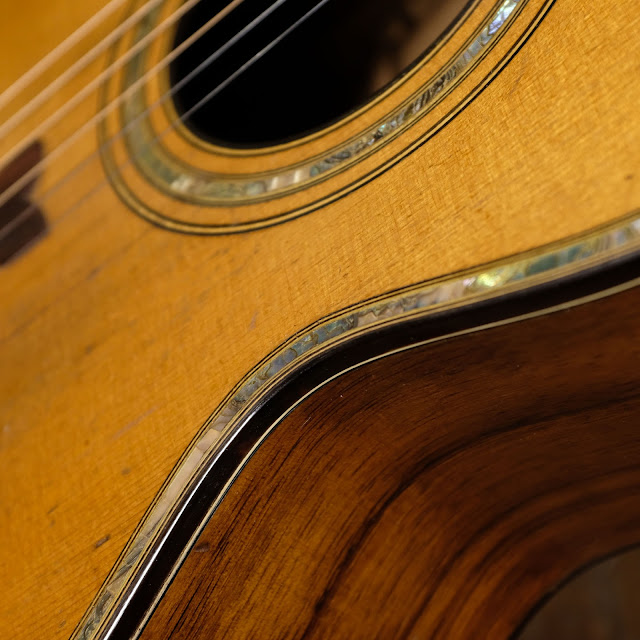1920s Harmony-made Supertone Artist Parlor Guitar
I've worked on various airplane-bridged Harmony products, but this is the fanciest one I've had the chance to do surgery on yet. Its top and soundhole are pearl-trimmed and it has solid koa back and sides rather than the more-usual figured mahogany I find on these. While it meets all the specs for the "Supertone Artist" model, the inlay in the fretboard is only simple dots -- though it does have nice multi-ply tortoise binding instead of black.
It's an 0-size instrument and has a short scale, so it fits the modern image of a "parlor" guitar. The body outline is the same shape featured on almost every other Harmony 12-fret guitar of the time, though its ladder bracing is a little bit different from the average Harmony box. While most Harmonies had two ladder braces below the soundhole, a bridge plate/strapping brace, and then a brace below the plate, this one has no bracing on the lower bout. This is compensated-for by having the longer bridge -- though, as you'd expect, the top does dome/belly around the bridge area because of tension-over-time. The upshot of the altered bracing pattern is that this is a louder, more robust guitar than the usual Harmony fare. It's interesting, though, because it sounds a lot fuller and better out front than it does from behind. It's got that projection thing going on.
Old work on the guitar included a botched neck reset and some saddle shaving. My fresh work included a proper neck reset, fret seating and level/dress, repairs to the one big crack on the top of the guitar (it's cleated and filled its entire length), a saddle-slot fill and new saddle slot cut (as well as new bone saddle), and minor cosmetic touch-ups here and there. It plays beautifully, now, and excels as a fingerpicker or light strummer. Due to the fret level/dress, the neck is effectively straight and stable.
Specs are: 24 1/8" scale, 1 13/16" nut width, 1 5/8" string spacing at the nut, 2 5/16" spacing at the bridge, 13 3/8" width at the lower bout, 9 15/16" upper bout, and 3 3/4" side depth at the endblock. Strings are 46w, 36w, 26w, 20w, 14, 10 and that's as heavy as I'd go on it for standard tuning. These are very lightly-braced. Action is spot-on at 3/32" EA and 1/16" DGBE at the 12th fret. There's room to come down on the saddle and the slot is deep enough to shim-up if higher action is preferred. The neck has a flat-profile fretboard and a medium soft C/V shape to its rear.
How about all that pearl? This thing is certainly a looker.
The top is solid spruce, the back and sides are solid koa, and the neck is mahogany. The fretboard is stained maple while the bridge is proper rosewood. Everything is original on the guitar except for the new ebony bridge pins and the new bone saddle.
The headstock has a rosewood veneer and bone nut.
Note that in the past, someone plugged and redrilled the pinholes. The spacing is not exact and I may fill and redrill them another time to get the perfect.
The crack that runs to the treble side of the bridge on the top is cleated on its entire length, filled, and stable.
Ooh-la-la, right?
The tuners are original Waverly units from the time and have ivoroid buttons.
There are three plugged tailpiece holes at the endblock area.
Here's the Sears Supertone label. There's no date mark, but it seems via other online references that these models were 1927/28 in era.




























Comments
My other comment is the inlay dots on the fret board does not match my original fretboard work. I can send a photo id anyone is interested
Thanks.
Donnie Barbra